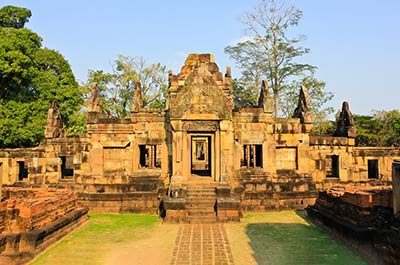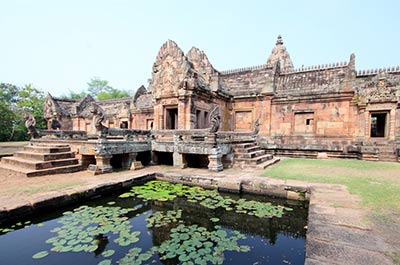
Wat Kamphaeng Laeng Khmer temple
Wat Kamphaeng Laeng
12th Century Khmer “sandstone wall temple”
Phetchaburi town
The Wat Kamphaeng Laeng is a Khmer sanctuary in the town of Phetchaburi. It is the most Southern of the Khmer temples in Thailand and the oldest structure in Phetchaburi town. The sanctuary is fairly small and not as impressive as better known Khmer temples as Phimai or Phanom Rung in Northeast Thailand.
12th Century “sandstone wall temple”
The temple, which name translates to “sandstone wall temple” was founded towards the end of the 12th century during the reign of King Jayavarman VII, one of Angkor’s greatest Kings, at the time when the Khmer empire stretched out as far West as Burma and as far South as the Malay peninsula. Wat Kamphaeng Laeng was constructed as a Hindu sanctuary and later converted into a Buddhist sanctuary.
Surounded by sandstone wall
The ancient temple is surrounded by a wall made of huge sandstone blocks, most of which is still standing. In the wall were gopura, gates giving access to the grounds. As most Khmer temples in Thailand and Cambodia, the Wat Kamphaeng Laeng is oriented towards the East.
Bayon style prangs and a chapel
The temple comprises of five Bayon style prangs and a small chapel, which is a later addition.

Five laterite prangs
Originally there were five laterite prangs. The largest prang standing at the center is surrounded by four smaller prangs at the corners. Today four remain, one of the prangs has collapsed.
Classic corncob shape
The top of the prangs is classic corncob shape, receding in size towards the top. All structures were completely covered in stucco. Some of the intricate stucco ornamentations in flower motifs still remain today. A few of the niches in the prangs enshrine badly damaged and weathered images of the Buddha.
The main, South and North tower stand on an elevated base. Each prang enshrined the image of an idol like Shiva and Vishnu, the Hindu Gods worshipped by the ancient Khmer.
The main shrine
The main shrine is the largest and stands at the center, surrounded by four corner prangs. It stands on a base with redented corners. On each of its sides is a portico with an entrance. The top which has collapsed consisted of five receding stories. Most of the stucco has disappeared, although some of the intricate flower motifs still remain. The sanctuary was dedicated to Shiva. Today the prang enshrines a seated image of the Buddha.
The surrounding shrines
On each side of the South shrine is a portico. The Eastern portico contained the entrance, while the Western portico enshrined an idol. The arches of the North and South portico were adorned with stuccoed sculptings. The top consists of five receding stories. The North shrine is similar to the South shrine, but its top has collapsed. Very little remains of the West shrine, which had the same layout as the North and South shrine. The East shrine has a portico in all four directions. Both the East and West portico contained entrances, while the other two were false entrances. On each side of the porticoes is a false balustrade window.

Active temple
The Wat Kamphaeng Laeng is located on the grounds of an active Buddhist temple built in the 1950’s. Around the ancient structures are a modern ubosot (ordination hall) and kuti, the monks living quarters.
Excavations
During excavations by the Thai Fine Arts Department in 1987 several images were found, including a Nak Prok image (Buddha seated on the coiled up body of the snake Mucalinda and sheltered by its hoods) and an image of Lokeshvara, the Bodhisattva of compassion.
How to get to the Wat Kamphaeng Laeng
The temple is found on Pho Karong road in Phetchaburi town. The easiest way to get there is by chartered songthaew. Alternatively, arrange a private taxi through hotel.
Opening hours
The temple grounds open daily during daylight hours.
Entrance fee
Admission is free.
Other Khmer temples across Thailand


Ancient Khmer temples of Thailand
- Visit the ancient Khmer temples of Thailand
- Private or group tours
- One day or multiple days
- English speaking guide
Ancient Khmer Temples